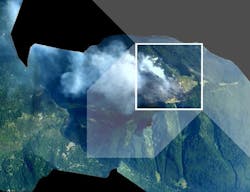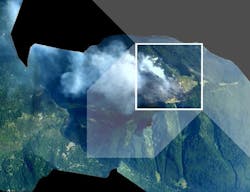Real-time video enhancement required
Fighting crime, one frame at a time: AMD and MotionDSP push the boundaries of video for the U.S. Department of Defense.
U.S. Department of Defense (DOD) officials, as part of the organization’s ongoing investment in new technologies for intelligence, surveillance, and reconnaissance (ISR) in various locales, including Iraq and Afghanistan, are interested in adopting advanced processing and graphics technologies.
In the modern era, automated video recording is featured on virtually all military vehicles, including manned vessels like fighter jets, trucks, and tanks, as well as unmanned aircraft systems (UAS) such as Predator unmanned aerial vehicles (UAVs).
“In 2009, more than 24 years’ worth of video was recorded in Iraq and Afghanistan,” says Sean Varah, founder and CEO, MotionDSP in Burlingame, Calif. “The amount of video that is being recorded in theater is absolutely staggering.”
Because of this growing dependence on recorded imagery, the US government has started to write general requirements for real-time image processing to improve the quality of the video they capture. “Analysts need better video so they can see what’s going on – the military calls it ‘better situational awareness’.” says Varah.
“Our differentiation is our ability to deliver real-time super-resolution image processing on full motion video, and that’s thanks the GPU. As far as I know right now, we’re the only ones doing this. Real-time processing is a critical requirement, because without real-time it’s pretty much useless to the analyst who has to make real-time decisions.”
Tough customer with tough requirements
In a situation where the clarity of a live video stream can help save lives, there’s a high bar set in terms of technology standards and requirements. “The DOD is a very hard customer to satisfy,” Varah explains. “All our image processing has to be capable of doing 1080p video resolution, which is huge. 1080p is six times the resolution of standard-definition (SD) video. To give you a sense, we estimate that a SD video stream takes 150 to 200 gigaflops of compute to process. A 1080p stream requires something in the order of 1.2 teraflops to process.
“On the highest end AMD graphics processors, we’re able to do 1080p video in real-time, and two streams of 720P video. And we’re not able to do this on any other GPU,” says Varah.
MotionDSP also recently adapted Ikena for OpenCL, an open standard that ensures that the software will be supported by multiple hardware vendors. “The U.S. government customers are not crazy about anything that is sole source. Whenever they do procurement, they’re looking for something where they’ve got competition. And they look for open standards. They have literally had the experience where vendors give them systems that are so vertical, and so closed, that people have died because they can’t get these systems to talk to each other,” Varah explains.
“Porting to OpenCL was great because it got us an open platform that will be a standard for years to come. But in particular, working closely with AMD to tune our algorithms specifically to take advantage of AMD’s architecture was also highly valuable because we were able to extract a level of performance that we hadn’t gotten from competing hardware,” Varah says. “More performance means we can deliver more capabilities to our DOD customers: higher-resolutions, better processing quality, and more simultaneous streams.”
Energy-efficient installations
In addition to unrivaled processing throughput and graphics horsepower, MotionDSP discovered AMD’s commitment to energy efficient technologies could help them address challenging new use cases where Ikena could be of benefit.
“There are really two advantages to AMD. One is on the high-end, where AMD is getting us easily 30 to 60 percent better performance over a competitor’s products. On the low end, AMD lets us do sophisticated image processing with significantly less power — 30 to 50 percent less. And that’s really important when you want to embed our capability directly on a UAV, which has strict requirements for heat, weight, and power,” says Varah.
High-speed, floating data center
In June 2011, MotionDSP demonstrated its capability on a DoD experimental boat — an 88-foot, carbon fiber catamaran featuring four 1500HP diesel engines, eight channels of live HD video, and two AMD-powered Colfax CX1250-N4 rackmount servers running Ikena software.
“We installed a mini-cloud of AMD hardware. We had two AMD-powered 1U servers, each with dual AMD Opteron 6100 Series processors and dual ATI FirePro V8800 professional graphics cards,” Varah describes. “Through those two machines we piped about 8 channels of video, so each of the AMD-based servers was doing real-time processing on up to 4 channels of video at any one time.
“The experiment was really to test how much better we could make the existing military-grade sensors,” Varah adds. “We took live feeds from the ship’s SeaFlir and GyroCam cameras and processed them in real-time. And what was amazing was we proved we could make them substantially better — an Air Force analyst commented that our software improved the video by up to 2 video NIIRS levels. It basically showed that all you need to do to get better video is to plug some AMD hardware into this rack and improve your cameras instantly. So that was a huge win.”
The results of Ikena running on AMD-powered servers in an extremely challenging instance aboard a high-speed, experimental stealth craft impressed the audience. “We had more than six different DoD agencies come to our Stiletto demonstration. It was so successful that we now have a number of deployments, or ‘transitions’ as the DOD calls them, happening now – customers who are choosing to integrate our software into a variety of different platforms, from Full Motion Video analyst’s workstations to large enterprise server installations,” Varah says. “As a result of our success improving sensors, the Stiletto program has invited us to come back to install our capabilities as a permanent capability.”
The Assistant Secretary of Defense for Research & Engineering, Rapid Reaction Technology Office (RRTO) sponsors Stiletto for technology demonstrations.
Technology partnership with a future
With a vast and ever-increasing quantity of video-hours captured-due to the expanding fleet of military vehicles deployed and the multiplying number of cameras mounted per vehicle — it appears that there will be plenty of new opportunities and challenges for MotionDSP to tackle going forward.
For example, technology that could perform automated tactical analysis of video imagery would greatly reduce the burden on humans facing insurmountable hours of footage. “The next problem that we’re working on is really doing more to reduce what we call the Operator Workload, to help the DoD do more with fewer people,” says Varah. “This sort of advanced computer vision will require even more compute power than we’re using now.”
There’s also a growing demand for Ikena at home, in the public safety sector. Avwatch, an aerial surveillance provider, supports disaster recovery ground teams with real-time video from above. Recent projects include Hurricane Irene and Montana forest fires.
As Avwatch President Chris Kluckhuhn explains: “We’re using Ikena to stabilize and enhance video. When we’re streaming live broadcasts, all the Ikena improvements to the video are being done in real-time, before they’re distributed live.” In the case of the Montana forest fires, Ikena’s Mosaicking feature was able to instantly stitch together several minutes of video to create a wide area “satellite view” of the forest fires.
“MotionDSP is at the leading edge of using computing technology to take postproduction enhancements to a real-time environment and give capabilities to first-responders that we’ve never had before,” says Kluckhuhn.
Information about AMD professional graphics is available online at www.amd.com/firepro.



